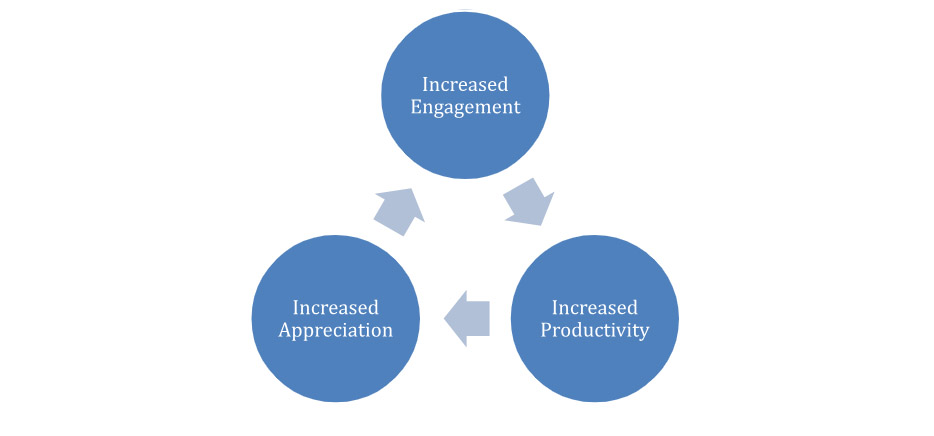
How to improve employee engagement is a question that resonates deeply with modern organisations.
A highly engaged workforce not only boosts productivity but also creates a positive work environment, driving businesses forward. In today’s competitive landscape, ensuring employees are invested in their roles goes beyond mere job satisfaction.
It’s about creating a workplace where individuals feel valued, understood, and inspired.
This guide offers actionable strategies to elevate employee engagement, transforming not just the workplace culture but also the bottom line.

The Importance of Employee Engagement
The core of any successful organisation is its employees. Engaged employees are the foundation for innovation, creativity, and superior customer service. Without this element, workers are simply functionaries, living from pay-check to pay-check. They won’t go above and beyond to push the organisations goals forward.
When an individual is engaged, they are connected to their work, aligned with the company’s values, and committed to contributing to the organisation’s success.
This sense of connection and purpose invariably leads to improved job performance, reduced turnover rates, and higher levels of job satisfaction.
It’s simply more efficient to have employees slotted into roles they are best suited to, can grow within, and are excited to perform.
The challenge then, is to measure and increase employee engagement, either by recruiting better suited employees, or enabling workers to get more out of their employment.

Learn How To Create Personal Learning Journeys For FREE!
And there’s a problem with employee engagement. A recent Gallup poll in the US saw it dropping for the first time in a decade, with just 32% of workers feeling engaged (34% in 2021 and 36% in 2022).
This gradual but consistent decline may have a range of contributing factors, including individuals rethinking their roles post-COVID, and a move towards hybrid and remote working, but it remains a problem in search of a solution.
However achieved, improved employee engagement can benefit both employer and workforce in a range of ways. Let’s look at some of the main advantages of focusing on this issue.
Linking Engagement to Workplace Productivity
Employee engagement and motivation go hand in hand with productivity. Engaged employees often outperform their disengaged counterparts. An MIT Management report on three research studies concludes that, “across the three studies, the researchers found that employees who were consistently engaged over time had the best performance — that is, they had low engagement variability.”
The MIT research highlights that while there will always be some variability in engagement, since no worker is superhuman, when variance is reduced, productivity increases.
Workers may feel more engaged when they can see tangible results related to their efforts, and the causal connection between effort and achievement becomes a positive reinforcement loop:

Workers who feel productive and appreciated tend to be more focused, take fewer sick days, and are more proactive in problem-solving.
A different Gallup report (from 2018, prior to the overall decline setting in) revealed that organisations with high employee engagement report a 21% higher level of productivity. That’s a significant boost to the bottom line and should have the knock-on effect of higher employee retention.
The Ripple Effect of Engaged Employees
Among the best news about employee engagement is that it can create another positive reinforcement loop, as engaged, appreciated, and rewarded employees act as role models for less engaged colleagues, lifting their engagement rates:

Engaged employees create a ripple effect throughout an organisation. Their enthusiasm and dedication can be infectious, leading to a more collaborative and cohesive team environment.
This is an effect most clearly observable within sales teams where leaderboards act as motivators for less well-performing employees to step up their game to rise to the exalted heights of top salesperson.
Engaged employees often become advocates for the company, promoting its values both internally and externally. Recruitment and retention are further boosted when a culture of engagement and high performance is promoted.
Identifying Barriers to Engagement
Before implementing strategies on how to increase employee engagement, it’s crucial to identify potential barriers.
Common barriers include:
- A lack of clear communication: it hasn’t been made clear what is expected of an employee. Perhaps the job specification is too vague, or metrics and KPIs have not been supplied. Lines of reporting may not have been clarified, and the employee may not feel they have sufficient resources to help them achieve ambitious targets.
- Inadequate training resources: the employee doesn’t have the tools at their disposal to become good at their role. They may have the potential for greatness, but it remains untapped. This leads to frustration and disengagement.
- Limited growth opportunities: the role the employee is in has no room for training or development. When asked “where do you see yourself in five years’ time?” the worker could only answer “in the same role” or “at a different company.” Disengagement often sets in, since the employee feels underappreciated, or simply bored.
there may have been an error in recruitment, where an employee has been hired who simply does not have the basic skills necessary to fulfil the role. There may be potential to upskill the employee or move them to a more appropriate position.
Of course, the above factors are not exclusive – the problem may be a combination of multiple factors.
Once the applicable barriers are identified, businesses can tailor their engagement strategies to address these specific challenges.

Key Strategies to Boost Employee Engagement
Fortunately, there are a range of tried-and-tested strategies which have been proven to increase employee engagement, and thus boost productivity and performance.
These include:
1. Open Communication Channels
Companies can promote a culture where employees feel comfortable sharing their ideas, concerns, and problems. Rather than feeling afraid to speak up, a two-way dialogue between management and employees is encouraged.
For this to work, the organisation must foster a culture of openness, where workers can speak up without fear of consequence. Fortunately, there are a range of ways to do this.
Open-door policies, regular town-hall meetings, and feedback platforms can be instrumental. Companies can have away days which provide neutral environments in which to provide feedback and brainstorm ideas.
When brainstorming, it is vital that judgements are not assigned to ideas or concerns. These are simply voiced, shared, and considered.
Not all feedback will be helpful, but all employees given an opportunity to do so will feel valued and listened to, and these are vital components of feeling appreciated (which will lead to improved engagement).

2. Recognition and Rewards
Recognising employee achievements, big or small, can go a long way.
Recognition can take the form of accolades issued on a public forum, such as your intranet, Slack channel, or newsletter. Rewards can include bonuses, prizes, gifts, or other tangible benefits.
While private congratulations do count, studies have shown that congratulations uttered publicly count for more.
As reported on engagement platform TerryBerry, Gallup polled employees and found that 37% of workers would declare that their company had a culture of recognition when accolades were delivered publicly, compared to just 11% who would do so when only private congratulations were offered.
However, current thinking is that the best course of action is to personalise recognition to each employee. For some employees, a bonus is the best form of recognition, while for others a kind word or celebration lunch from their manager counts for a lot more. In time, managers get to know how best to recognise and reward each employee.
Regular accolades, bonus schemes, or even a simple ‘thank you’ can significantly boost employee morale, which enhances engagement.
There are a host of employee reward platforms that companies can partner with to formalise the process of recognition, but managers should never underestimate the effect of a personal gesture of gratitude and appreciation.
3. Professional Development Opportunities
A great way to improve employee engagement is to offer training programs, workshops, and seminars. When employees see an investment in their growth, they are more likely to return that investment in the company.
Such courses should not be imposed externally (as mandatory training). Instead, companies should ask their employees what they would like to learn that would benefit them within their role or help them progress.
Workplace training, and its effect on employee retention, has been studied by research firm SHRM. Their report “2022 Workplace Learning and Development Trends” included the following statistics:
- 83% of HR managers believe workplace Learning & Development helps them attract talent, and 86% believe it assists with employee retention.
- 48% of employees say training opportunities were a significant factor in choosing where to work.
- 76% of workers say they Would be more likely to stay with their current company when it offers training and development opportunities.
That last statistic is remarkable – fully three in four employees value training and development in their role. It behoves employers to listen.
4. Flexible Working Conditions
It’s undeniable that since the COVID-19 pandemic, working conditions, and methods of working, have changed dramatically. Hybrid and remote positions are on the rise, with Forbes reporting that almost 13% of employees now work from home, while over 28% enjoy a mix of in-office and home working.
Although accelerated by the pandemic, trends towards remote working, flexible hours and other accommodations were already underway prior to 2020. Forbes predicts that by 2025, over 32 million Americans will work remotely, 22% of the US workforce.
Whether you consider this a positive or negative outcome, it is an inevitable one. Fighting this trend will not benefit employers in terms of boosting engagement.
It’s not hard to see why employees appreciate this type of flexibility. They can better adjust their work-life balance, can arrange working patterns around childcare, and can work in sprints when they feel more engaged and productive. This flexibility should be viewed by employers as ways to boost employee performance.
Of course, any degrees of flexibility permitted can be measured with KPIs and other metrics, so that if the arrangement isn’t working, it can be adjusted accordingly.

Tools and Metrics to Track Engagement Levels
To gauge the effectiveness of engagement strategies, businesses need reliable tools and metrics. Here are some of the most popular ways to measure what can seem an intangible benefit:
- Employee surveys, where aggregated responses can be quantified to identify patterns in engagement and productivity.
- Pulse checks, where individual employees, or focus groups, meet with management to talk about how they feel about their role and their productivity, in an open, non-judgemental environment.
- Feedback platforms can offer invaluable insights, with digital suggestion boxes, mini surveys, and quizzes offering valuable feedback on how workers feel about different aspects of their work. These can then be aggregated and quantified.
- Metrics such as the ENPS (Employee Net Promoter Score) can provide a quantifiable measure of employee sentiment. ENPS is simply the average score given to a question such as “how likely are you to recommend your employer to others?” with 0 being very unlikely and 10 extremely likely.
By mixing and matching several of these methods, employers can gain a composite portrait of how engaged their workforce is. learning
Tracking these metrics over time can help organisations refine their engagement strategies, ensuring continuous improvement.
Check out our blog post on How to Measure Employee Engagement for more hints and tips on how to gauge the effectiveness of your engagement strategies.
Engagement is a Process, not a Destination
Boosting employee engagement is not a one-time task, but an ongoing journey.
Almost no company can boast perfect engagement, and even the most pro-employee culture may have unhelpful recruitment policies or poorly written job specifications which reduce engagement.
By understanding the significance of engaged employees, recognising barriers, and implementing effective strategies, businesses can foster a productive and beneficial workplace.
Remember, employee engagement doesn’t just boost the bottom line; it creates a vibrant, fulfilling environment where talented and hard-working individuals grow and thrive.
In time, an organisation can grow a reputation for being a great place to work, and thereby secure and retain the very best talent.
Conclusion
If you’re looking to enhance employee engagement in your workplace and reap the benefits of a more productive and positive environment, Skillshub is here to help.
With our range of resources, including bespoke training courses and a dynamic eLearning platform, we are poised to assist you in unlocking the full potential of your workforce. Contact us today to take the first step towards a transformed workplace culture.
As an eLearning company, Skillshub is committed to creating efficient and impactful learning experiences. Contact us to find out more.
You can also check out our list of 100 Employee Engagement Ideas & Strategies To Motivate and Inspire!













